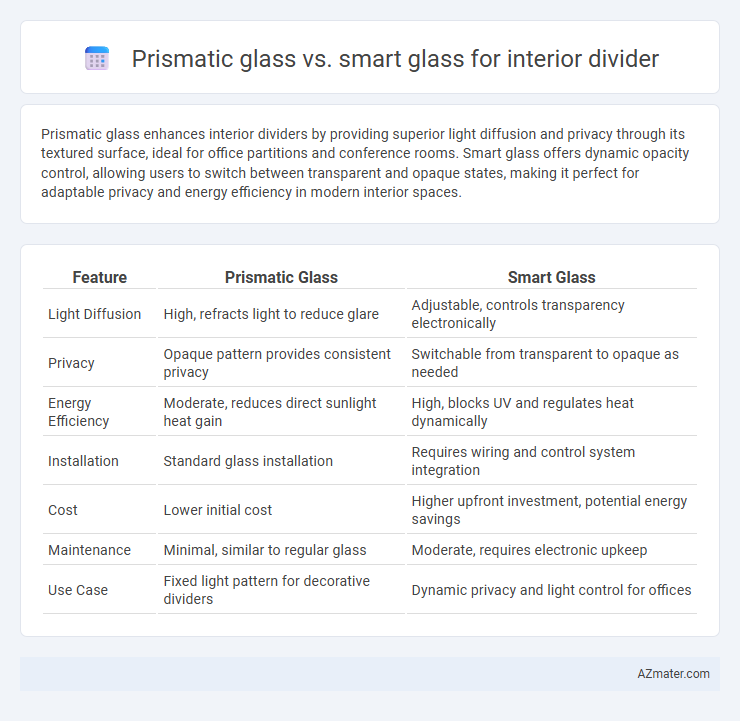Prismatic glass enhances interior dividers by providing superior light diffusion and privacy through its textured surface, ideal for office partitions and conference rooms. Smart glass offers dynamic opacity control, allowing users to switch between transparent and opaque states, making it perfect for adaptable privacy and energy efficiency in modern interior spaces.
Table of Comparison
| Feature | Prismatic Glass | Smart Glass |
|---|---|---|
| Light Diffusion | High, refracts light to reduce glare | Adjustable, controls transparency electronically |
| Privacy | Opaque pattern provides consistent privacy | Switchable from transparent to opaque as needed |
| Energy Efficiency | Moderate, reduces direct sunlight heat gain | High, blocks UV and regulates heat dynamically |
| Installation | Standard glass installation | Requires wiring and control system integration |
| Cost | Lower initial cost | Higher upfront investment, potential energy savings |
| Maintenance | Minimal, similar to regular glass | Moderate, requires electronic upkeep |
| Use Case | Fixed light pattern for decorative dividers | Dynamic privacy and light control for offices |
Introduction: Prismatic Glass vs Smart Glass
Prismatic glass enhances interior dividers by refracting light to create vibrant, dynamic visual effects while maintaining privacy and natural illumination. Smart glass, equipped with electrochromic technology, offers adjustable opacity, enabling users to switch from transparent to opaque for customizable privacy and light control. Both materials serve functional aesthetics, with prismatic glass emphasizing light manipulation and smart glass prioritizing adaptability in interior environments.
Defining Prismatic Glass: Features and Aesthetics
Prismatic glass features a textured surface designed to refract and scatter light, creating dynamic patterns and enhanced privacy within interior dividers. Its geometric patterns contribute to an aesthetic that balances natural illumination with artistic light diffusion, making spaces feel open yet visually intriguing. Compared to smart glass, prismatic glass offers a fixed decorative effect without requiring electrical control, blending functionality with timeless design.
What Is Smart Glass? Technology and Functionality
Smart glass, also known as switchable glass, utilizes technologies such as liquid crystal, electrochromic, or suspended particle devices to dynamically control light transmission and privacy in interior dividers. It can change from transparent to opaque with electrical activation, offering customizable privacy, energy efficiency, and natural light management. This functionality makes smart glass ideal for adaptable office spaces, conference rooms, and modern interiors seeking enhanced control over light and privacy.
Privacy Control: Comparing Prismatic and Smart Glass
Prismatic glass features embedded microstructures that diffuse light while maintaining visibility, offering moderate privacy ideal for areas needing partial separation without complete opacity. Smart glass employs electrochromic or liquid crystal technology to switch between transparent and opaque states instantly, providing dynamic privacy control suitable for adaptable environments. For interior dividers, smart glass delivers superior privacy flexibility compared to prismatic glass by allowing users to adjust transparency on demand.
Light Transmission and Diffusion Capabilities
Prismatic glass offers superior light transmission by efficiently redirecting natural light while reducing glare, making it ideal for interior dividers that require consistent brightness without harsh shadows. Smart glass provides adjustable light diffusion through electrochromic technology, allowing users to control opacity and privacy levels while maintaining variable light flow. Both materials optimize daylight use, but prismatic glass excels in fixed light diffusion, whereas smart glass delivers dynamic control over light transmission and privacy.
Energy Efficiency and Sustainability Considerations
Prismatic glass enhances natural light distribution, reducing the need for artificial lighting and lowering energy consumption, while its static design offers durability with minimal maintenance. Smart glass provides dynamic control over light and heat transmission through electrochromic technology, enabling users to adjust transparency based on real-time conditions, optimizing HVAC energy efficiency. Both materials contribute to sustainable interior dividers by improving daylight utilization and minimizing energy waste, but smart glass offers advanced adaptability for fluctuating environmental demands.
Design Flexibility for Modern Interiors
Prismatic glass offers enhanced design flexibility for modern interiors by diffusing light and creating dynamic visual effects without compromising privacy. Smart glass provides adaptable transparency settings, allowing seamless transitions between opaque and clear states, which suits multifunctional spaces requiring customizable ambiance. Designers prefer prismatic glass for artistic patterns and light modulation, while smart glass excels in high-tech environments demanding interactive privacy control.
Installation and Maintenance Requirements
Prismatic glass installation requires precise alignment to maintain its light-diffusing properties, often necessitating professional handling to avoid damage and ensure optimal visual effects. Smart glass panels demand careful electrical wiring and integration with control systems, which can extend installation time and complexity compared to traditional glass. Maintenance for prismatic glass mainly involves regular cleaning to preserve clarity, whereas smart glass requires monitoring of electronic components and occasional software updates to maintain functionality and responsiveness.
Cost Comparison: Initial Investment and Long-Term Value
Prismatic glass typically requires a higher initial investment due to its complex manufacturing process and specialized materials, while smart glass, especially those with electrochromic technology, can also be costly but often includes installation in the price. Over the long term, smart glass offers greater value through energy savings by controlling light and heat transmission, reducing HVAC costs, whereas prismatic glass primarily enhances natural light diffusion without such dynamic control. Maintenance costs for smart glass can be higher due to electronic components, but its adaptability and energy efficiency often justify the upfront expenses in commercial and residential interior dividers.
Best Applications: Choosing the Right Glass for Your Space
Prismatic glass excels in interior dividers where natural light control and decorative patterns enhance aesthetic appeal, ideal for office spaces and conference rooms requiring both privacy and ambient illumination. Smart glass offers dynamic opacity control, making it perfect for adaptable environments like meeting rooms, healthcare facilities, and luxury residences demanding privacy on demand and energy efficiency. Selecting the right glass depends on balancing design goals, privacy needs, and dynamic light management to optimize interior space functionality.

Infographic: Prismatic glass vs Smart glass for Interior divider
 azmater.com
azmater.com